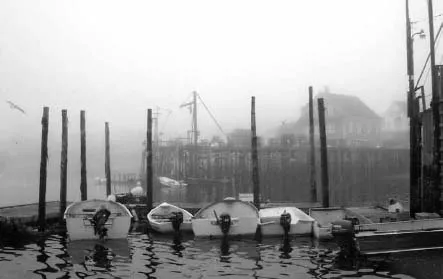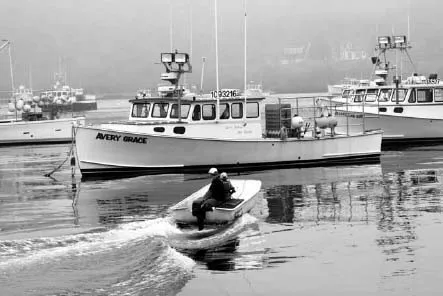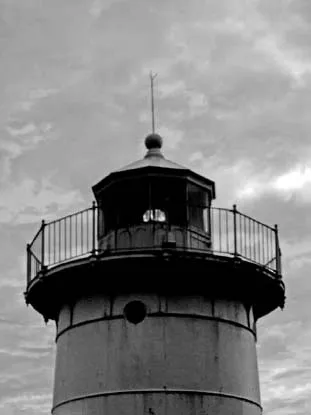![]()
A DAY OUT ON THE LOBSTER BOAT
UP BEFORE SUNRISE
One of the first things to know about a day out fishing is that it starts early. Most fishermen will be up and out the door no later than 5:00 a.m. Often it’s much earlier. They start early to try to beat the wind, which tends to pick up in the afternoon. They also will likely be logging a ten-to twelve-hour day on the ocean, and an earlier start means an earlier finish. For fishermen working inshore, the tides will often play some role in when they head out to traps.
CHECKING THE CONDITIONS: TIDE, WIND AND FOG
Before leaving home, a fisherman will always check the tides and the weather conditions. The night before, he’ll consult his tide calendar and watch the local weather forecast. In the morning, he’ll check the direction and speed of the wind and the thickness of the fog, if there is any. These factors will affect how he approaches his day of fishing and whether it’s viable to fish that day at all. He’ll either check his weather vane, tune into the local weather station or call out to another fisherman who’s already out on the water via VHF to ask, “How is it out there?” Because the conditions inshore often differ from the conditions on the water, consulting another fisherman is the one sure way to know whether it’s worth heading out. As long as it’s not blowing a gale or thick o’ fog, he’ll probably go.
Lobstermen fish through all sorts of weather. They go out when it’s raining. They go out when it’s snowing. They go out when it’s subzero. Their thick, waterproof Grundéns protect against extreme weather, and a special hat, called a sou’wester, can be worn to wick away extreme rain. At times, I actually enjoyed fishing in the rain when I was working on the boat. There was something about seeing the wet weather all around me yet being completely protected inside my Grundéns that almost made me feel cozy. The sight of raindrops falling onto the ocean and dissolving into the waves is also quite beautiful. Even sleet and snow often won’t deter a fisherman from going to haul. High winds and thick fog are the most likely reasons a fisherman will skip a day on the water.
It’s quite obvious why fishermen are reluctant to fish in high winds. Such conditions create high waves that make it challenging, and sometimes dangerous, for the fisherman to tend his gear. Rough seas make it perilous to work among the shoals and ledges where many fishermen place a portion of their traps. Shallow, rocky inlets are ideal spots for catching lobsters but tricky places from which to retrieve lobster traps unless the seas are calm. I remember several spots along the shore where my father would set a trap that we would only be able to haul every few weeks, when the weather was just right. Southerly winds are especially precarious for fishermen working along the Maine shores, as there is less room for error. If a fisherman’s engine breaks down or he gets rope in his propeller during a southerly wind, it can quickly blow him onto the shore.
In the case of deeper-water fishing, high winds make it difficult to keep the boat stationary and stable while hauling. Seas are best handled by keeping the boat in motion and driving into the waves. When hauling traps, this is not always possible. You have to keep the boat in a fixed place to ensure the trap comes up well and that your trapline doesn’t drift into that of another fisherman. If it happens that the wind is blowing crossways to the direction in which you have to haul, the boat can really take a kicking from the waves. While a fisherman’s boat is almost always sturdy enough to take the thrashing, the fisherman himself is not. He can easily get caught out by a rogue wave, tossed against some equipment on the boat and end up with broken ribs or a dislocated shoulder.
At what wind speed will a fisherman hang up his hat for the day? It all depends on when the wind comes up. As the wind tends to pick up later in the day, fishermen are often already out hauling when things get blustery. In this case, fishermen will often put up with thirty-five to forty knots of wind in order to finish out their day. They’ll just batten down the hatches and be extra careful while hauling. Before they head in, they’ll call out to any remaining fishermen working the area to make sure those fishermen are okay. This is especially true if just a couple of fishermen remain offshore together in rough weather. Often they’ll decide to head their boats for home at the same time so they can look out for each other along the way. When it gets to forty knots, things can happen fast, and you want someone close by if something goes wrong.
While a fisherman might finish out his day with forty knots, he would seldom venture out to traps in the morning with that much wind. Usually when the wind speed picks up to around twenty to twenty-five knots, a fisherman will question whether he’ll make a day of it. In general, Down East fishermen are less likely to head out to haul in easterly and northerly winds, as they give the ocean more of a chop. A southwest wind tends to be an easier wind in which to fish.
I could write an entire chapter on Maine fog. It’s the topic of many a VHF conversation and a subject about which fishermen love to moan. This is because we have a lot of it! Especially during the summer months, warm air reacts with the cold Down East waters, causing the moisture in the air to condense. Fog is most prevalent when the winds are blowing southwest, as the breezes push warm air from inland down onto the coast. Some mornings, you can wake up to the whole harbor and town being shut in with fog. When this happens, the fishermen need to make a judgment as to whether or not to go out. Thick fog makes it hard to see one’s gear and dangerous to navigate the boat. Though fishermen paint their buoys bright colors to show up in fog and have special electronic equipment to help them navigate in unclear conditions, fishing on a foggy day is still less than ideal. It’s very easy for a boat or rocky outcrop to quickly “come up on you” when you’re out in the fog, so extra caution must always be taken.
Skiffs at rest in the harbor on a foggy day.
When the harbor is shut in with fog, a fisherman will call out to any other fishermen already on the water and ask if it’s worth going out, as sometimes the fog is thicker inland than out on the water. A typical response from a fisherman might be that it’s so thick “you can cut it with a knife” or that it’s “as thick as mud.” Thick fog is also often described as “pea soup fog.” Some fishermen have a landmark on shore that they use to judge if it’s too thick to go out. When I was growing up, there was a hackmatack tree two-tenths of a mile down the road from our house. On foggy mornings, my father would look out the kitchen window, and if he couldn’t see the hackmatack tree through the fog, he wouldn’t go out. Some summers the Down East coast will be shut in with fog for weeks at a time. When this happens, fishermen just have to pick the best of the bad days and plow through it.
HEADING OUT TO THE MAIN BOAT: THE SKIFF
If the tides are right, the fog not too thick and the winds not too strong, the fisherman will make his way out to traps. He’ll haul on his boots, hop in his pickup and head down to the harbor where his boat is moored. On a good spring, summer or fall day, the harbor area of a typical Down East fishing village will be lined with pickups and the harbor will be empty of boats. There are few parking lots and even fewer parking wardens in Down East Maine, so the fisherman will just park his pickup along the side of the road or down on a wharf, leaving the doors unlocked and the keys right in the ignition.
The fisherman’s sternman will usually meet him at the wharf, and together they will make their way out to the lobster boat. Again, most lobster boats are moored in the middle of a harbor or an inlet where there is protection from extreme weather, as well as sufficient depth of water to ensure the boats won’t ground out at low tide. In order to get to and from the lobster boat, the lobster fisherman will keep a smaller boat, called a skiff or tender, moored to a float at the end of the wharf where he fishes.
Heading to the boat for a day of fishing. Courtesy of Laurie Cates.
Today, more and more fishermen are using fiberglass boats with outboards as their tender. These outboards make the process of getting out to the lobster boat quite quick and effortless. Merely tug on the cord to start the outboard, untie the line and off you go. Of the sixty fishermen I interviewed for this book, over half now use outboards as tenders.
Back when I was growing up and fishing with my father, more fishermen in my town used rowing skiffs to get out to their boats. There was something quite serene about rowing out to the boat in the early morning, hearing the oars dip in and out of the water. The harbor would be quiet, save for the cry of seagulls and the distant rumble of another boat engine firing up for a day of fishing. In summer, the sun would often be rising over the island, creating a postcard perfect scene. In the fall, cold air would create a layer of steamy mist hovering just above the water’s surface. Everything felt very peaceful and still in these moments, but I knew I had a long day of work ahead of me before I’d be sitting in that skiff again to head back home.
On the way out to the boat, my father would do the rowing, but sometimes, at the end of the day, I’d row us back to the wharf. Only then could I appreciate the art of rowing and how hard it is to achieve perfect alignment and rhythm with the oars. I’ve spent years watching my father and grandfather row with great skill, and yet, to this day when I get behind a set of oars my stroke is always lopsided.
Often, older skiffs that have been retired as tenders make their way up to a fisherman’s front lawn and become a playground for his children. In these older skiffs, kids will spend countless hours pretending to haul traps. This was the case with our family. My father’s older wooden skiff was placed on our front lawn, and my brother and I used it to play “lobster fishing” when we were growing up.
Other times, old rowing skiffs are left down at the float to be used for a spot of exercise. Rowing can be a very pleasurable way of getting a workout, as it takes physical effort and coordination. If you ever get a chance to borrow a fisherman’s skiff for a spot of rowing, just remember to put it back properly. Stow the oars under the seats to keep them secure, hinge down the oar locks so they don’t dig against other boats and tie up the skiff with the same knot used by the owner.
PREPPING THE BOAT AND PLOTTING THE COURSE
Once the fisherman gets out to his lobster boat, he’ll fire up the engine. The process of starting up a lobster boat is similar to starting a car, performed by turning a key in the ignition. As with their pickup trucks, most fishermen never take the key out of the ignition. Once the engine is running, the fisherman will turn on his electronics and pump the bilge. He’ll then unhook his boat from the mooring and head out to traps.
As he heads out of the harbor or inlet in which his boat is moored, the lobster fisherman will consult his radar, loran and Global Positioning System (GPS) satellite plotter equipment, along with his compass. Though modern electronics have made course-plotting easier, the humble compass is still a fundamental navigational aid. While working on the boat, I never learned to use the GPS or loran, but my father made sure I could steer the boat by compass. Before the advent of modern electronics, the compass was used, along with a clock and a fixed engine speed, to navigate in adverse conditions through the process of dead reckoning.
Along with the compass on his boat, the fisherman will usually pass several other classic navigational aids on his way out to sea, such as a channel marker or a lighthouse. These fixtures have become such icons of Maine, filling our postcards and picture books, that it’s easy to forget the vital role they’ve played in helping bring fishermen safely home through the years. Down East Maine alone has twenty-six lighthouses dotting its coast. One of these lighthouses is perched on an island at the head of my harbor. Called Little River Light, it was manned by my great-grandfather, Willie Corbett, during the early 1900s and by my great-great-grandfather, Roscoe Johnson, in the 1890s. Now automated, it continues to emit beacons of light, which help guide fishermen into our harbor in dark, stormy or foggy weather. Every lighthouse along the Maine coast is a unique height and has an individual flash pattern, called its characteristic. For example, the Little River Light tower is forty-one feet high and flashes every six seconds. Each fisherman is required to stow a lighthouse book on his boat so he can identify which light signal is associated with his home port.
As the fishermen steam past these icons, they’ll be busily prepping the boat and themselves for the day. Bait will be brought out from under the stern or washboards of the boat, where it was stored to keep the gulls from getting at it. Grundéns oilskins will be removed from their hooks and put on. Baskets will be put in place and tanks filled with circulating salt water to await the arrival of the lobster catch. Once the boat engine has warmed up a bit, the fisherman will open her up to cruising speed and steady his course for the first of his traps. The day of fishing is about to begin.
Sunrise over Little River Light. Courtesy of Bill Kitchen.
FINDING ONE’S TRAPS: THE LOBSTER BUOY
A common question asked of lobster fishermen is, “How do you find your traps?” While navigational aids and landmarks help to a degree, the lobster buoy is the key marker for a lobsterman’s traps. Each fisherman has a distinct buoy color and pattern to distinguish his traps from those of his fellow fishermen. Buoy colors range from traditional reds, blues and greens to bright pinks and electric yellows. The brighter the buoy, the better chance it has of being visible through the fog. Buoy patterns often consist of lengthwise or crosswise stripes.
A shoreline littered with a kaleidoscope of different-colored buoys is one of the most beautiful and iconic images of Maine, yet this coloring serves a very...



